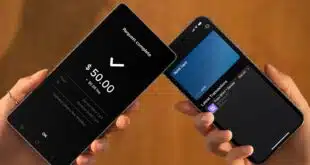A new smart-phone app hopes to give retailers an edge in capturing sales when consumers use their mobile devices in their stores. Dubbed SelfPay, the app enables consumers to pay for merchandise while standing in a store aisle and leave without stopping at a cash register.
Developed by Digital Retail Apps, a Toronto-based firm, SelfPay’s first retailer is Lux Beauty Boutique in Edmonton, Alberta. To use the app, consumers must download it to an iPhone, create an account, and add a payment method. Currently, SelfPay supports cards carrying the MasterCard Inc. and Visa Inc. brands, says Wendy MacKinnon Keith, chief executive and founder.
There are plans to offer other payment options, such as PayPal and Google Wallet, she says. Transactions are processed at card-not-present interchange rates, which are somewhat higher than rates for card-swiped transactions.
Once a SelfPay account is set up, a consumer can shop with it inside the store. SelfPay taps into the iPhone’s geo-location abilities to know when the device is inside a participating retailer. “We are planning on introducing a more precise method of determining the user's location in the near future,” MacKinnon Keith says. “We will be testing a Bluetooth LE system using the new Beacon technology early in 2014.” Bluetooth LE is a low-energy type of wireless connection between devices. It is being used in Apple Inc.’s iBeacon and PayPal is developing a beacon-based mobile commerce system called PayPal Beacon. It, too, relies on Bluetooth technology to locate shoppers inside stores. They also will be able to pay for merchandise.
After recognizing the consumer inside a store, the app displays a custom retailer-branded screen, which unlocks the capability to make a purchase. The user scans either the Universal Product Code or a bar code generated by the retailer’s point-of-sale system for items they are interested in and SelfPay displays an accurate in-store price and product description, also pulled from the retailer\'s POS system. The shopper then adds the item to her cart, selects a payment method, and enters a SelfPay PIN. The transaction is processed through Digital River Inc. and then routed to the merchant\'s payment processor.
Digital River subsidiary Beanstream provides the gateway for SelfPay. Vend Ltd. and LightSpeed Retail Inc., POS system developers, also work with Digital Retail Apps.
SelfPay generates a detailed receipt with an embedded quick-response (QR) code for display on the consumer device. On the way out of the store, the consumer may be asked to show proof of purchase by an associate. MacKinnon Keith says verification is at the retailer’s discretion.
The shopper retrieves the digital receipt from SelfPay, which is scanned using the SelfPay Verification app. That app displays the purchase details along with any notices that may raise concerns regarding the validity of the purchase. An example is if a purchase was made an hour before the scan. This may mean that the shopper is attempting to leave with a second set of items after the original purchased items have left the store, says MacKinnon Keith. If valid, the associate approves the purchase in-app.
Retailers can designate scanning locations, and use more than one device to minimize the potential for lines to form, she says.
“The final scan on completion of an in-aisle transaction is meant to be a very quick process,” MacKinnon Keith says. “We believe that when an individual is in control of their experience, including the pace, they will be far more satisfied with this experience than having to wait behind a line of shoppers and cashiers who may be moving at a slower pace.”
The app is intended to help retailers combat showrooming, which is what happens when consumers check out products using their smart phones in physical stores before buying them at a lower price from online merchants, she says.
“With SelfPay, the shopper has a go-to app where they know they will find the desired product information,” she says. “SelfPay then lets the shopper actually purchase the item to take home right away. SelfPay does not show competing retailer\'s prices. There is also the huge benefit to the consumer of not waiting in line to check out. This will help greatly with in-store shopping-cart abandonment and can increase our retailers’ sales.”
Indeed, merchant use of apps like SelfPay, may be the next phase of retailing, suggests Lauren Freedman, president of e-commerce consulting firm The E-tailing Group Inc. “Anything that can help retailers check out faster is always appreciated, particularly among today’s time-starved shopper,” Freedman says. “The question will be if this is something handled on a per-merchant basis or will aggregated models have broad enough appeal.”
Merchants pay an undisclosed fee to Digital Retail Apps and to Beanstream for the payment gateway access. Digital Retail Apps does not mark up the fees paid to Beanstream or the merchant’s payment processor.
This is not the first app to offer consumer-driven in-store checkout. AisleBuyer LLC once offered a similar service, but nary a word has been heard from the company since Intuit Inc. bought it in 2012.





